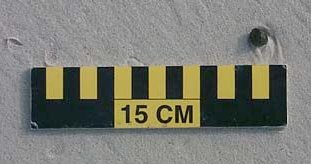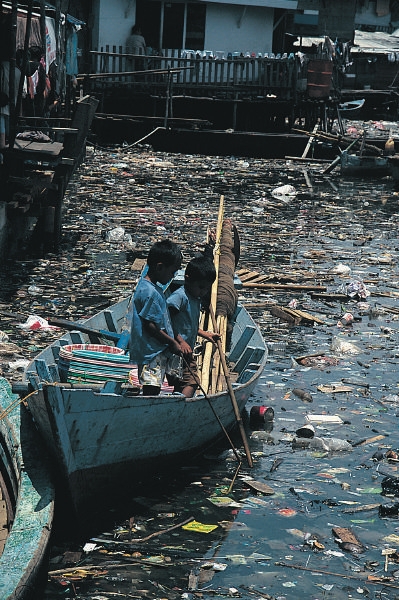|
Tarball (oil)
A tarball is a blob of petroleum which has been weathered after floating in the ocean. Tarballs are an aquatic pollutant in most environments, although they can occur naturally and as such are not always associated with oil spills. Tarball concentration and features have been used to assess the extent of oil spills and their composition can also be used to identify their sources of origin. They are slowly decomposed by microorganisms such as '' Chromobacterium violaceum'', ''Cladosporium resinae'', ''Bacillus submarinus'', ''Micrococcus varians'', ''Pseudomonas aeruginosa'', ''Candida marina'', and ''Saccharomyces estuari''. Tarballs may be dispersed over long distances by deep sea currents. The density of tarballs depends on the solids picked up in the weathering process. They can range in density with some being more dense than seawater, which, at 1.025 g/ml, is more dense than the density of fresh water. When the tarballs are less dense than seawater, they can travel over grea ... [...More Info...] [...Related Items...] OR: [Wikipedia] [Google] [Baidu] |
Candida Marina
Candida, or Cándida (Spanish), may refer to: Biology and medicine * ''Candida'' (fungus), a genus of yeasts ** Candidiasis, an infection by ''Candida'' organisms * Malvasia Candida, a variety of grape Places * Candida, Campania, a ''comune'' in Avellino, Italy * Candida Casa, a church in Whithorn, Dumfries and Galloway, Scotland * Aguas Cándidas, a municipality in Burgos, Castile and León, Spain People * Candida (given name) * Aldoino Filangieri di Candida (died 1283), nobleman in the Kingdom of Naples * Candida Maria de Jesus (1845–1912), Spanish nun and saint * Candida, pen name of Eibhlín Ní Bhriain (1925–1986) Theatre, film and performing arts * ''Candida'' (play), by George Bernard Shaw ** ''Candida'' (1962 film), an Australian television adaptation * ''Cándida'' (1939 film), a 1939 Argentine musical film drama directed by Luis Bayon Herrera **This film was followed by several others featuring the same character played by Nini Marshall including: ** '' ... [...More Info...] [...Related Items...] OR: [Wikipedia] [Google] [Baidu] |
Ocean Pollution
Marine pollution occurs when substances used or spread by humans, such as industrial, agricultural and residential waste, particles, noise, excess carbon dioxide or invasive organisms enter the ocean and cause harmful effects there. The majority of this waste (80%) comes from land-based activity, although marine transportation significantly contributes as well. Since most inputs come from land, either via the rivers, sewage or the atmosphere, it means that continental shelves are more vulnerable to pollution. Air pollution is also a contributing factor by carrying off iron, carbonic acid, nitrogen, silicon, sulfur, pesticides or dust particles into the ocean. The pollution often comes from nonpoint sources such as agricultural runoff, wind-blown debris, and dust. These nonpoint sources are largely due to runoff that enters the ocean through rivers, but wind-blown debris and dust can also play a role, as these pollutants can settle into waterways and oceans. Pathways of pollutio ... [...More Info...] [...Related Items...] OR: [Wikipedia] [Google] [Baidu] |
Oil Spills
An oil spill is the release of a liquid petroleum hydrocarbon into the environment, especially the marine ecosystem, due to human activity, and is a form of pollution. The term is usually given to marine oil spills, where oil is released into the ocean or coastal waters, but spills may also occur on land. Oil spills may be due to releases of crude oil from oil tanker, tankers, Oil platform, offshore platforms, drilling rigs and Oil well, wells, as well as spills of Oil refinery, refined petroleum products (such as gasoline, diesel fuel, diesel) and their by-products, heavier fuels used by large ships such as bunker fuel, or the spill of any oily refuse or waste oil. Oil spills penetrate into the structure of the plumage of birds and the fur of mammals, reducing its insulating ability, and making them more vulnerable to temperature fluctuations and much less buoyancy, buoyant in the water. Cleanup and recovery from an oil spill is difficult and depends upon many factors, including ... [...More Info...] [...Related Items...] OR: [Wikipedia] [Google] [Baidu] |
Boom (containment)
A containment boom is a temporary floating barrier used to contain an oil spill. Booms are used to reduce the possibility of polluting shorelines and other resources, and to help make recovery easier. Booms help to concentrate oil in thicker surface layers so that skimmers, vacuums, or other collection methods can be used more effectively. They come in many shapes and sizes, with various levels of effectiveness in different types of water conditions. Often the first containment method to be used and the last equipment to be removed from the site of an oil spill, they are "the most commonly used and most environmentally acceptable response technique to clean up oil spills in the United States." Booms used in oil spills can be seen as they rest on the surface of the water, but can have between 45 and 120 cm (18 to 48 inches) of material that hangs beneath the surface. They are effective in calm water, but as wave height increases oil or other contaminants can easily wash ov ... [...More Info...] [...Related Items...] OR: [Wikipedia] [Google] [Baidu] |
Fresh Water
Fresh water or freshwater is any naturally occurring liquid or frozen water containing low concentrations of dissolved salts and other total dissolved solids. Although the term specifically excludes seawater and brackish water, it does include non- salty mineral-rich waters such as chalybeate springs. Fresh water may encompass frozen and meltwater in ice sheets, ice caps, glaciers, snowfields and icebergs, natural precipitations such as rainfall, snowfall, hail/ sleet and graupel, and surface runoffs that form inland bodies of water such as wetlands, ponds, lakes, rivers, streams, as well as groundwater contained in aquifers, subterranean rivers and lakes. Fresh water is the water resource that is of the most and immediate use to humans. Water is critical to the survival of all living organisms. Many organisms can thrive on salt water, but the great majority of higher plants and most insects, amphibians, reptiles, mammals and birds need fresh water to survive. Fresh ... [...More Info...] [...Related Items...] OR: [Wikipedia] [Google] [Baidu] |
Seawater
Seawater, or salt water, is water from a sea or ocean. On average, seawater in the world's oceans has a salinity of about 3.5% (35 g/L, 35 ppt, 600 mM). This means that every kilogram (roughly one liter by volume) of seawater has approximately of dissolved salts (predominantly sodium () and chloride () ions). The average density at the surface is 1.025 kg/L. Seawater is denser than both fresh water and pure water (density 1.0 kg/L at ) because the dissolved salts increase the mass by a larger proportion than the volume. The freezing point of seawater decreases as salt concentration increases. At typical salinity, it freezes at about . The coldest seawater still in the liquid state ever recorded was found in 2010, in a stream under an Antarctic glacier: the measured temperature was . Seawater pH is typically limited to a range between 7.5 and 8.4. However, there is no universally accepted reference pH-scale for seawater and the difference between measurement ... [...More Info...] [...Related Items...] OR: [Wikipedia] [Google] [Baidu] |
Density
Density (volumetric mass density or specific mass) is the substance's mass per unit of volume. The symbol most often used for density is ''ρ'' (the lower case Greek letter rho), although the Latin letter ''D'' can also be used. Mathematically, density is defined as mass divided by volume: : \rho = \frac where ''ρ'' is the density, ''m'' is the mass, and ''V'' is the volume. In some cases (for instance, in the United States oil and gas industry), density is loosely defined as its weight per unit volume, although this is scientifically inaccurate – this quantity is more specifically called specific weight. For a pure substance the density has the same numerical value as its mass concentration. Different materials usually have different densities, and density may be relevant to buoyancy, purity and packaging. Osmium and iridium are the densest known elements at standard conditions for temperature and pressure. To simplify comparisons of density across different s ... [...More Info...] [...Related Items...] OR: [Wikipedia] [Google] [Baidu] |
Ocean Current
An ocean current is a continuous, directed movement of sea water generated by a number of forces acting upon the water, including wind, the Coriolis effect, breaking waves, cabbeling, and temperature and salinity differences. Depth contours, shoreline configurations, and interactions with other currents influence a current's direction and strength. Ocean currents are primarily horizontal water movements. An ocean current flows for great distances and together they create the global conveyor belt, which plays a dominant role in determining the climate of many of Earth’s regions. More specifically, ocean currents influence the temperature of the regions through which they travel. For example, warm currents traveling along more temperate coasts increase the temperature of the area by warming the sea breezes that blow over them. Perhaps the most striking example is the Gulf Stream, which makes northwest Europe much more temperate for its high latitude compared to other areas at ... [...More Info...] [...Related Items...] OR: [Wikipedia] [Google] [Baidu] |
Saccharomyces Estuari
''Saccharomyces'' is a genus of fungi that includes many species of yeasts. ''Saccharomyces'' is from Greek σάκχαρον (sugar) and μύκης (fungus) and means ''sugar fungus''. Many members of this genus are considered very important in food production. It is known as the brewer's yeast or baker's yeast. They are unicellular and saprotrophic fungi. One example is ''Saccharomyces cerevisiae'', which is used in making bread, wine, and beer, and for human and animal health. Other members of this genus include the wild yeast ''Saccharomyces paradoxus'' that is the closest relative to ''S. cerevisiae'', ''Saccharomyces bayanus'', used in making wine, and ''Saccharomyces cerevisiae'' var. ''boulardii'', used in medicine. Morphology Colonies of ''Saccharomyces'' grow rapidly and mature in three days. They are flat, smooth, moist, glistening or dull, and cream in color. The inability to use nitrate and ability to ferment various carbohydrates are typical characteristics of ''Sacc ... [...More Info...] [...Related Items...] OR: [Wikipedia] [Google] [Baidu] |
Pseudomonas Aeruginosa
''Pseudomonas aeruginosa'' is a common encapsulated, gram-negative, aerobic–facultatively anaerobic, rod-shaped bacterium that can cause disease in plants and animals, including humans. A species of considerable medical importance, ''P. aeruginosa'' is a multidrug resistant pathogen recognized for its ubiquity, its intrinsically advanced antibiotic resistance mechanisms, and its association with serious illnesses – hospital-acquired infections such as ventilator-associated pneumonia and various sepsis syndromes. The organism is considered opportunistic insofar as serious infection often occurs during existing diseases or conditions – most notably cystic fibrosis and traumatic burns. It generally affects the immunocompromised but can also infect the immunocompetent as in hot tub folliculitis. Treatment of ''P. aeruginosa'' infections can be difficult due to its natural resistance to antibiotics. When more advanced antibiotic drug regimens are needed adverse effects may re ... [...More Info...] [...Related Items...] OR: [Wikipedia] [Google] [Baidu] |




.jpg)

